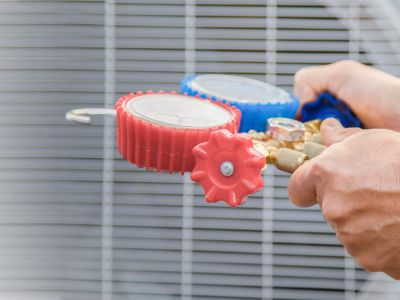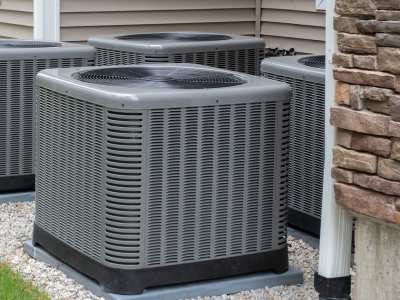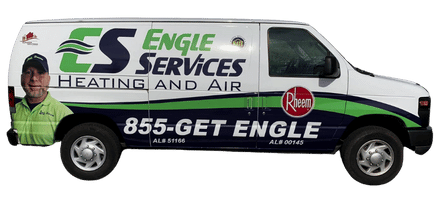You may have heard about a big change happening in the HVAC industry: the gradual shift away from R-410A to a newer, more environmentally friendly refrigerant called R-454B. This update has left many homeowners wondering what it means for their current heating and cooling systems, and how it could impact future repair or replacement decisions.
In this blog post, we’re going to break down what this change involves, why it’s happening, and how it could affect you and your HVAC system going forward.

What is a Refrigerant?
Refrigerants are essential to the operation of HVAC systems. They work by absorbing and releasing heat as they circulate through the system’s coils, shifting from a liquid to a gas and back again. This cycle is what allows your HVAC system to either cool or heat the air inside your home, depending on the settings and the season. These compounds are used in both traditional air conditioners and heat pumps. Without refrigerants, your system wouldn’t be able to transfer heat.
Why the Change?
This isn’t the first time environmental concerns have driven changes in HVAC refrigerants. Years ago, R-22 (also known as Freon), a hydrochlorofluorocarbon (HCFC), was widely used. However, it was found to contribute to ozone depletion, and its production was phased out.
To replace it, the industry moved to R-410A, a hydrofluorocarbon (HFC). While R-410A doesn’t deplete the ozone layer like R-22, it does have a high Global Warming Potential (GWP). In response to concerns about climate change, the American Innovation and Manufacturing (AIM) Act of 2020 was passed, aiming to reduce the use of high-GWP refrigerants and push the industry toward more sustainable options.
This brings us to R-454B, one of the new refrigerants being adopted to reduce environmental impact while still offering reliable HVAC performance.
What is R-454B Refrigerant?
R-454B is a next-generation refrigerant designed to offer similar performance to R-410A but with a significantly reduced environmental footprint. It’s a blend of R-32 and R-1234yf, both of which are lower-GWP components.
R-454B is classified as an A2L refrigerant. This means it is mildly flammable, but not dangerously so when handled properly and used in equipment designed to accommodate it. With the correct installation practices and system design, R-454B is considered safe for both residential and commercial use.
Its lower GWP and improved efficiency make it a leading choice for the future of HVAC technology.
How the R-454B Refrigerant Change Affects Existing AC Systems
If you currently own a system that uses R-410A, which is likely, you’re probably wondering what this shift means for you. Let’s go through some common questions homeowners may have:
What Do I Need to Do?
If your system is working well, there’s no reason to replace it just because of the refrigerant change. You can continue to use your R-410A unit as usual.
Will There Be Any Issues Servicing My Unit?
Not at all. HVAC professionals (like our team at Engle Services) will continue to service R-410A systems, and replacement parts and refrigerant for these units will remain available for the foreseeable future. The phase-out affects manufacturing and installation, not service.
Can I use R-454B in My R-410A HVAC Unit?
No. R-454B is not a “drop-in” replacement for R-410A. The two refrigerants operate under different pressures and require different system components. Attempting to use R-454B in a system designed for R-410A would damage the unit and void any warranties.

Considerations for Purchasing a New HVAC Unit
Under the AIM Act, manufacturers have now phased out production of new systems that use R-410A refrigerant. However, 2025 is the final year that R-410A units can still be installed from existing inventory. After this, all new systems will use low-GWP refrigerants like R-454B.
This makes 2025 a key year for homeowners considering replacement. If you’re planning to upgrade your system soon and are looking for a more cost-effective option, R-410A-based systems remain a solid and proven technology. They offer excellent performance and reliability, and technicians are very familiar with maintaining them.
It’s also worth noting that early reports suggest systems using R-454B may be 10% to 30% more expensive due to newer technology, design modifications, and limited supply in the early rollout. If you're looking to save money without compromising comfort, now may be the perfect time to purchase from the remaining inventory of R-410A systems.
In Summary
The transition to R-454B is a positive step for the environment and represents the future of HVAC technology. But if you currently have an R-410A system, there’s no need for alarm. You can continue using and servicing your system without issue. For those looking to replace their HVAC units soon, there’s still time to take advantage of the affordability and availability of R-410A systems before the full transition is complete.
If you have questions about your system or want to explore your options, feel free to reach out to us at Engle Services — we’re here to help guide you through the change.
Engle Services offers HVAC Installation, Maintenance, and Repair in Sylacauga, Talladega, Birmingham, Shelby County (Hoover, Chelsea), Alabaster, Pell City, Dadeville, Wetumpka, Montgomery, Fort Walton Beach (Florida) and all their surrounding areas.
 Ready to schedule with our team of HVAC Technicians, Electricians, and Plumbers?
Schedule an appointment online or give us a call at (855) GET-ENGLE
Ready to schedule with our team of HVAC Technicians, Electricians, and Plumbers?
Schedule an appointment online or give us a call at (855) GET-ENGLE
